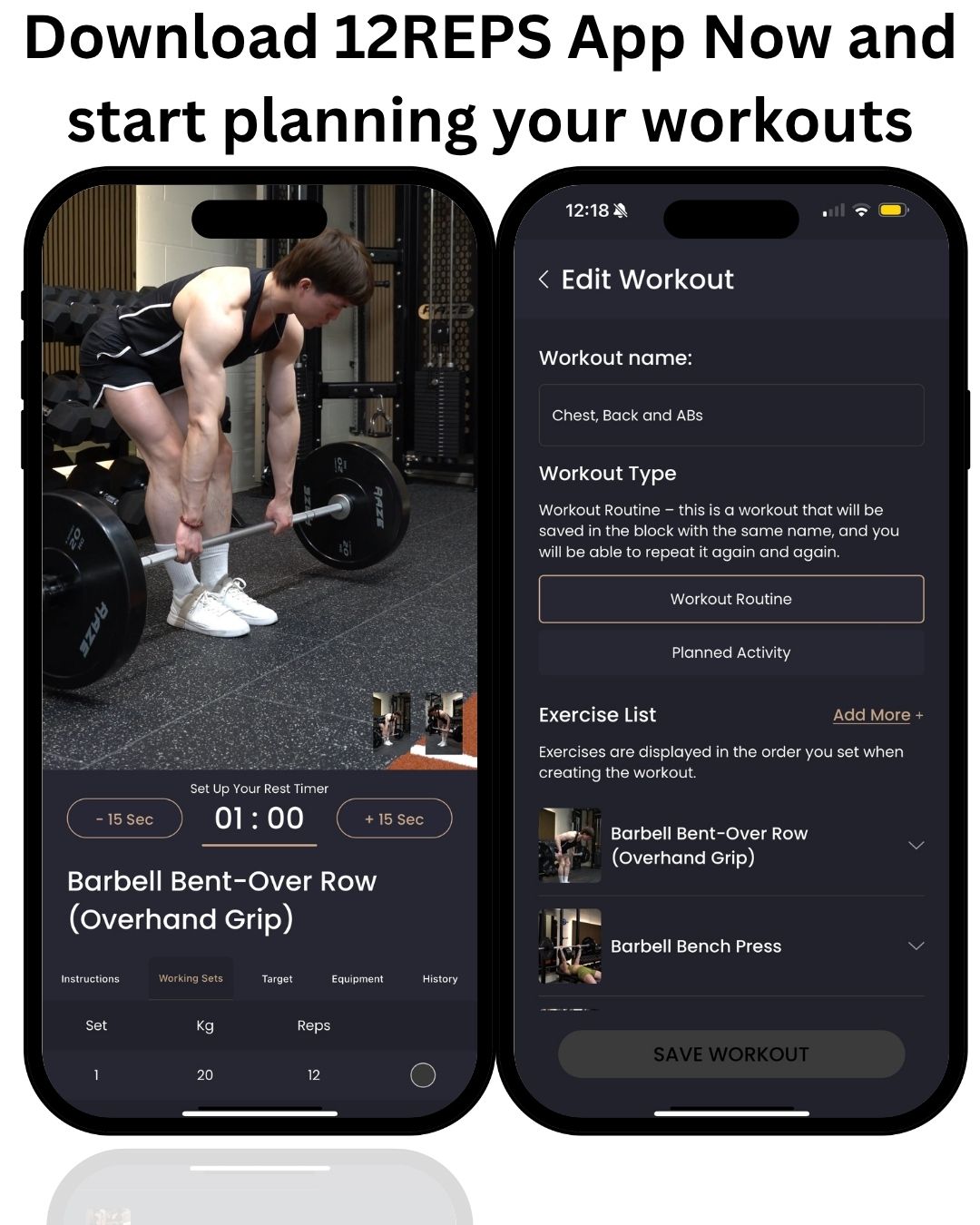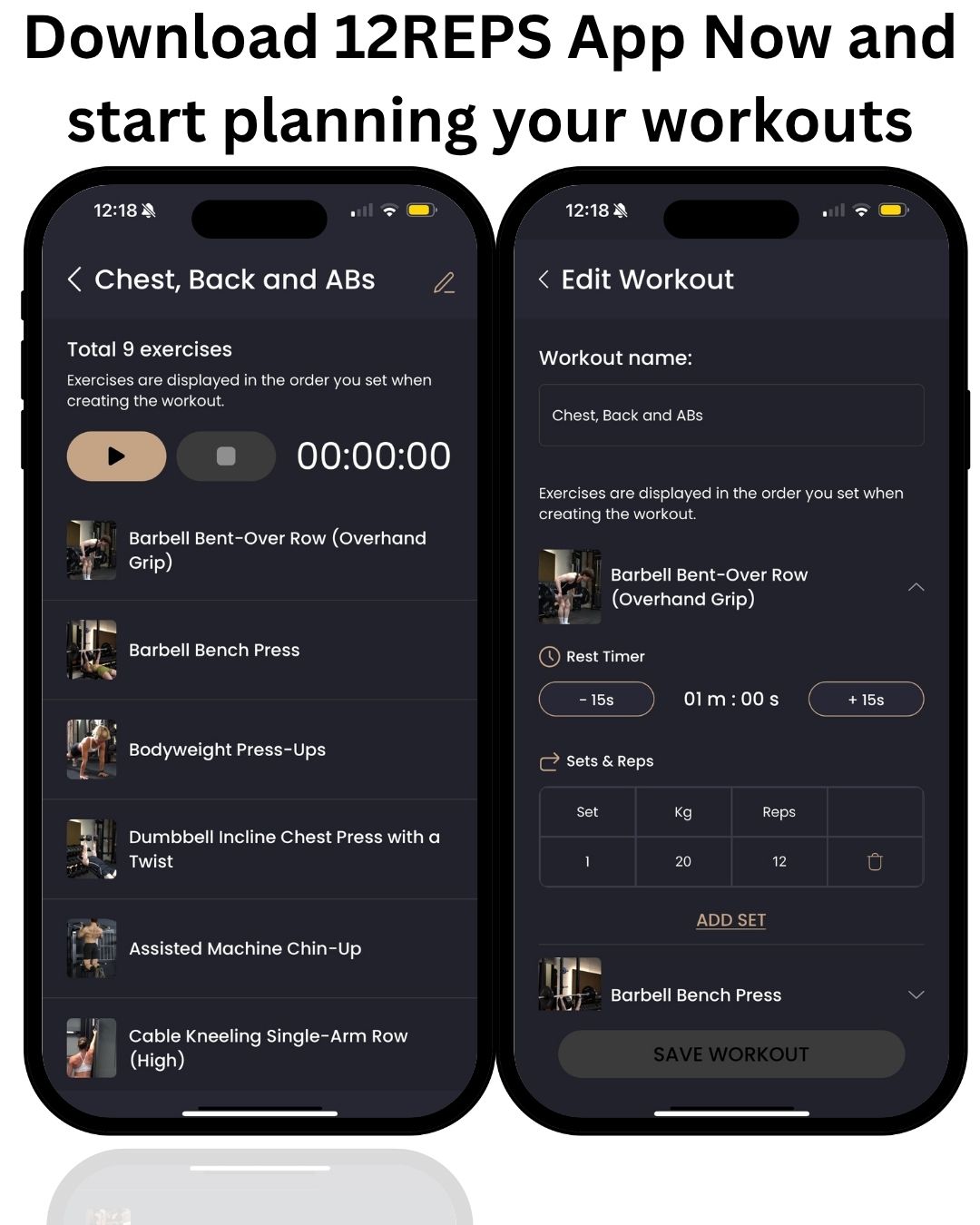By Will Duru, BSc (Hons) Sport and Exercise Science, Award-winning Personal Trainer with over 10 years of experience in strength training and optimising recovery
As personal trainer with over a decade of experience in strength training, I’ve seen firsthand what it takes to build serious muscle. It’s not about spending endless hours in the gym or following the latest fitness fads. It’s about applying a scientific approach to your training and recovery. In this article, I’ll break down the science of muscle growth and explain how using a planner and tracker app like 12REPS can be a game-changer for your progress.

The Pillars of Muscle Hypertrophy: What You Need to Know
Muscle hypertrophy, the scientific term for muscle growth, is a complex process. But at its core, it’s driven by three key pillars: mechanical tension, metabolic stress, and muscle damage [1].
Mechanical Tension: Lifting Heavy for Growth
Mechanical tension is the force placed on your muscles when you lift weights. This is the primary driver of muscle growth. When you challenge your muscles with a heavy load, you create tension that signals your body to adapt and grow stronger. Think of it as a conversation with your muscles. You’re telling them, “This is heavy, you need to get bigger and stronger to handle this next time.”
To maximise mechanical tension, you need to focus on lifting with proper form and progressively increasing the weight you lift over time. This is where a good workout planner and tracker becomes invaluable. It allows you to systematically plan your progression and ensure you’re consistently challenging your muscles.
Metabolic Stress: The “Pump” That Builds Muscle
Metabolic stress is that “pump” feeling you get in your muscles during a high-rep set. It’s caused by the buildup of metabolic byproducts like lactate in your muscles. While mechanical tension is the primary driver of growth, metabolic stress also plays a significant role. It can stimulate the release of anabolic hormones and promote cellular swelling, both of which contribute to muscle hypertrophy [2].
To increase metabolic stress, you can incorporate techniques like higher repetitions (12-15 reps), shorter rest periods (30-60 seconds), and advanced techniques like drop sets and supersets. A good app will allow you to easily incorporate these techniques into your workouts.
Muscle Damage: Tearing Down to Build Up
Muscle damage refers to the microscopic tears that occur in your muscle fibers when you train hard. This damage triggers a repair process that can lead to muscle growth. However, it’s important to note that more damage isn’t always better. Excessive muscle damage can lead to overtraining and hinder your progress. The key is to find the right balance between stimulating muscle growth and allowing for adequate recovery.

How a Muscle Building Planner and Tracker App Optimises These Pillars
Now that you understand the science of muscle growth, let’s talk about how a planner and tracker app like 12REPS can help you apply these principles to your training.
Programming for Progressive Overload
Progressive overload is the gradual increase of stress placed upon the body during exercise. It’s the single most important principle for long-term muscle growth. A good app makes it easy to program for progressive overload by allowing you to track your workouts and systematically increase the weight, reps, or sets over time. This ensures that you’re constantly challenging your muscles and providing the stimulus they need to grow.
Tracking Volume and Intensity
Training volume (sets x reps x weight) and intensity (% of your one-rep max) are two of the most important variables for muscle growth. A good app will automatically calculate and track these metrics for you, so you can ensure you’re doing enough work to stimulate growth without overdoing it.
Ensuring Adequate Recovery
Recovery is just as important as training when it comes to building muscle. A good app can help you manage your recovery by tracking your rest days, sleep, and even your nutrition. This allows you to make sure you’re giving your body the resources it needs to repair and rebuild muscle tissue.

With an app like 12REPS, you can create a workout plan that is perfectly tailored to your goals and experience level. Here’s a sample of how you might structure your plan:
- Training Split: A push/pull/legs split is a great option for intermediate to advanced lifters. This allows you to train each muscle group twice a week with adequate recovery time.
- Exercises: Focus on compound exercises like squats, deadlifts, bench press, and overhead press. These exercises give you the most bang for your buck by working multiple muscle groups at once.
- Sets and Reps: For your primary compound lifts, aim for 3-5 sets of 5-8 reps to focus on mechanical tension. For your accessory exercises, aim for 3-4 sets of 10-15 reps to focus on metabolic stress.
- Advanced Techniques: Incorporate advanced techniques like drop sets and supersets to further increase metabolic stress and stimulate muscle growth.

Conclusion
Building muscle is a science, but it doesn’t have to be complicated. By understanding the key principles of muscle hypertrophy and using a tool like 12REPS to apply them to your training, you can accelerate your progress and build the physique you’ve always wanted. Ready to get started? Download the 12REPS app and start your muscle-building journey today.

References
- Schoenfeld, B. J. (2010). The mechanisms of muscle hypertrophy and their application to resistance training. The Journal of Strength & Conditioning Research, 24(10), 2857-2872. https://journals.lww.com/nsca-jscr/fulltext/2010/10000/the_mechanisms_of_muscle_hypertrophy_and_their.40.aspx
- Schoenfeld, B. J. (2013). Potential mechanisms for a role of metabolic stress in hypertrophic adaptations to resistance training. Sports Medicine, 43(3), 179-194. https://link.springer.com/article/10.1007/s40279-013-0017-1
- Plotkin, D., Coleman, M., Van Every, D., Maldonado, J., & Schoenfeld, B. (2022). Progressive overload without progressing load? The effects of load or repetition progression on muscular adaptations. PeerJ, 10, e14142. https://peerj.com/articles/14142/










